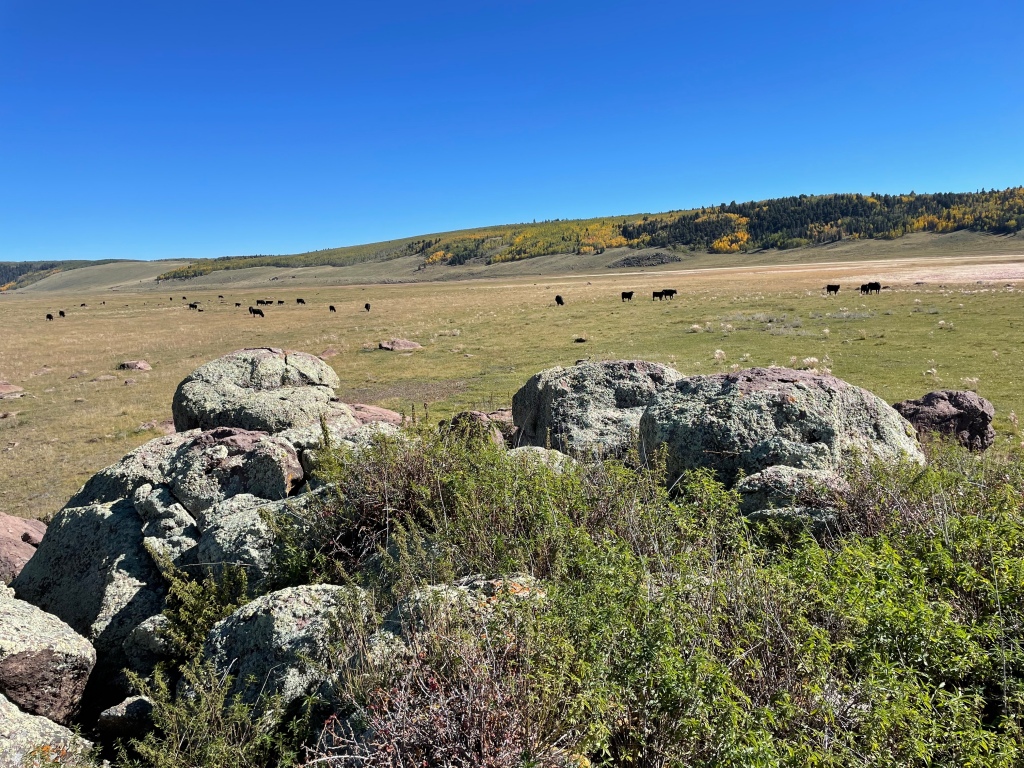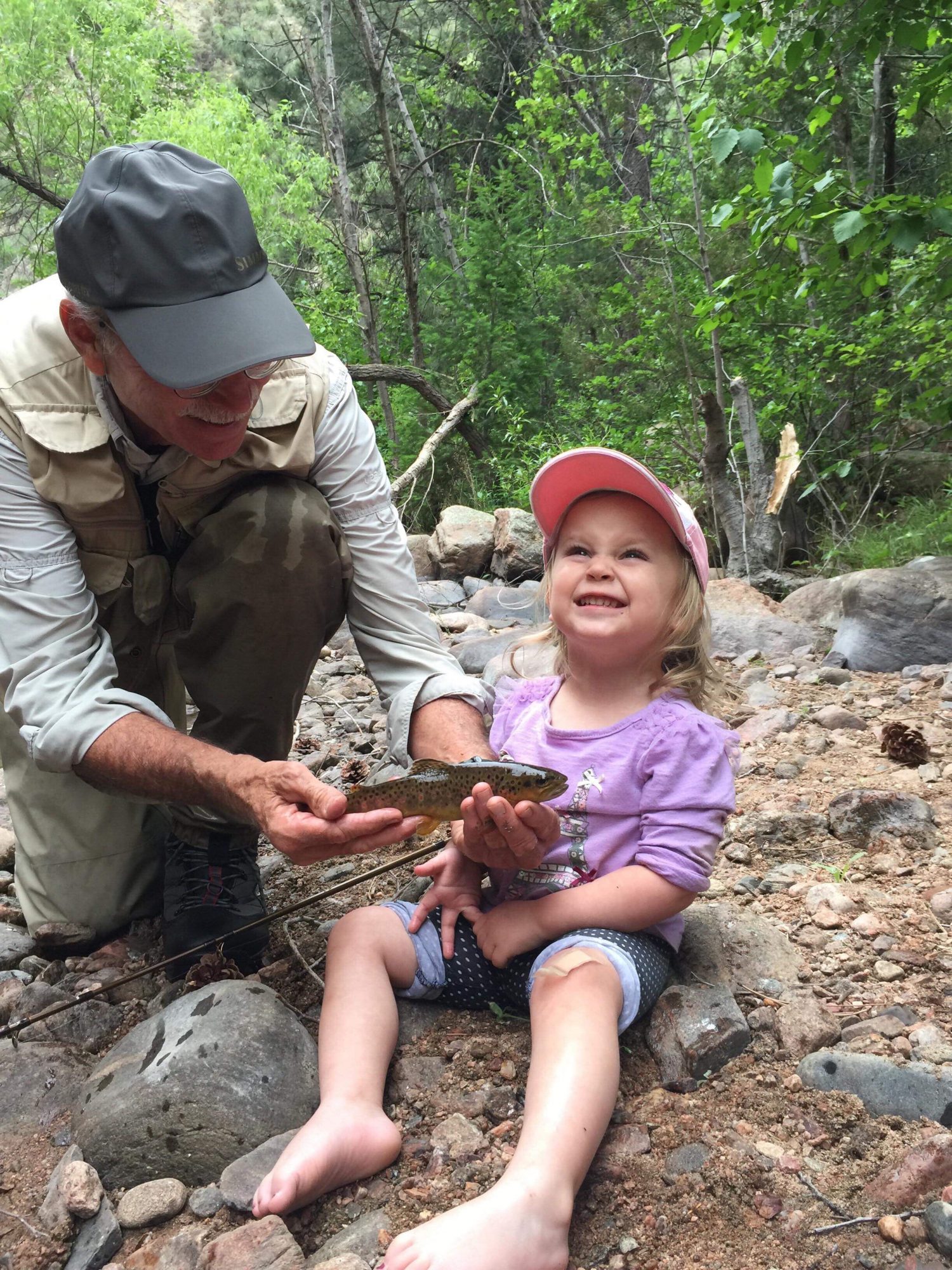Late September 2022
For my earlier articles on fishing La Jara Creek below La Jara Reservoir, see: https://hooknfly.com/2018/01/10/colorado-dreamin-on-such-a-winters-day-la-jara-creek-near-alamosa-co/ and https://hooknfly48.files.wordpress.com/2018/02/la-jara-creek-article-pdf.pdf
It’s the last day of my annual fall fishing fling in southern Colorado, and I’m on the road early at 7:30 a.m. from the Woods and River RV Park in Del Norte where I have been staying for the past week in my mobile fishing camp.


My aim is to explore Torsido and La Jara Creeks above La Jara Reservoir. I have had some terrific days fishing La Jara Creek below the dam, but this is my first venture above in the expansive treeless meadow. My research tells me both tiny creeks offer some fun fishing for small, colorful brookies and maybe even some cutthroats.
It’s about a two-hour drive from Del Norte to the lake, the last 20-mile stretch on a scenic but bumpy gravel road (Fdr240/259) that clearly hasn’t seen a grader blade since the end of our long monsoon season. The aspen on this route are at their best, so I just slow down and enjoy the brilliant display.




As I crest the hill, La Jara Reservoir greets me with a mirror-smooth surface reflecting the surrounding trees and foothills.
I continue north on the gravel road that flanks the lake and then above where I reconnoiter for the best jumping off point. The wide meadow hides any sight of either stream until I’m a mile or so above the lake where I catch a glance of La Jara Creek as it twists and turns, just a stone’s throw from the road. But I’m puzzled as I can’t see Torsido Creek anywhere, and up another mile La Jara Creek fizzles out completely at a big bend in the road. So I turn around and drive back down towards the reservoir, and finally decide about a mile above the lake to go exploring in the meadow, parking by the side of the road not far from a long hillock a couple of hundred yards to the east. My hunch is that Torsido flows in La Jara Creek somewhere on the other side of that hill out in the meadow. But it’s hard to gauge from the maps I have as the reservoir is low, exposing a lot of ground that’s usually underwater.
I suit up in my lightweight chest waders and carry my 4# wand rigged with a #18 Royal Trude to imitate the little hoppers that are still flitting about teamed with a #18 sparkle caddis larva dropper. I head south and, in a few minutes, cross La Jara Creek.
This is going to be challenging I think upon spying the tiny dimensions of the stream flanked by tall grass that will make casting challenging. Not only that, the shoreline in most places appears to have been the scene of a cow dance party, stomped into mush by the big bovine I can see in the distance. Did I mention the long in-stream strands of vegetation that promise to snag any fly beneath the surface? The good news is that the flow is strong and water cold, plus it’s a beautiful sunny day. Perfect for an easy ramble in the meadow.
I soon come to a lovely stand of grass with feathery purple spikes swaying gently in the light wind. I check with my favorite phone app, Picture This, and learn it’s called wild or foxtail barley.


The app notes that it is an easy plant to grow, suited perfectly for brown thumbs! As I admire the scene, something white catches my eye in the distance. I focus and see that it’s a big herd of pronghorn antelope lolling around at the upper end of the meadow. Then something spooks them, and they take off running lickety split.
Later I will cross paths with a big coyote which may explain their flight. It’s always a good sign to see some antelope when exploring a new water—usually means there aren’t many people around.
I continue south, aiming towards a big jumble of rocks surrounded by grazing cattle in the middle of the meadow not far from the lake. I hope to get up higher for a better view and maybe see Torsido Creek.




I use my farm boy mooing talent to scatter the dumbfounded bovine, except for the big bull who just glares at me. I hustle past him and scale the big rocks, a safe haven. They look strangely out of place in the serene meadow, seemingly plunked down randomly. I scan 360 degrees but the errant creek is nowhere to be seen. I think maybe it’s hidden in one of those ravines, hidden among the aspen, so I continue the trek.
To reach the foothills, I end up sloshing through some mucky marshland, then have to navigate a barbed wire fence. On reaching dry ground, I head east to check out one ravine, but only find a trickle there. Perplexed, I reverse course and check out another gulch.


Jumping Trials

Same story, including another stout barbed wire fence to surmount. Then as I crest another hill, a big coyote with a raggedy coat flashes by me, only 20 feet away. No wonder those pronghorns were skittish.
With no Torsido in sight, I decide to circle back to towards the road, have lunch that I stowed by La Jara Creek on the way in, and focus on fishing that water. It’s almost 12:30 p.m. when I reach the hillock close to La Jara Creek, having completed a fruitless three-mile circuit around the meadow. Thankfully, my magic RC Cola elixir banishes the depression and desperation that were starting to grab hold of me.
By 1 p.m. I’m ready to go again. I approach the stream cautiously and immediately spy a trout rising casually upstream. Casting is tricky if I stay too far back or kneel, courtesy of the tall grass and reeds along the shoreline. But if I get too close, I risk spooking the fish as well as having to deal with the mushy soup the cattle stomping has created. Against all odds, I throw a decent cast, and the fish inhales the dry without any hesitation. To my surprise, it’s a small tiger trout, a sterile hybrid of a male brook and a female brown trout that have been stocked in the lake.
They must be moving up the creeks in search of food, maybe snacking on the brook trout reputed to be here. Some anglers turn their noses up at tigers, but I am not complaining after wandering in the proverbial wilderness all morning.
I continue upstream and get several more small tigers, miss a good one in a big bend pool, then spook several more. The going is tough trying to work standing back from the shoreline so I defy conventional wisdom and start wading right up the middle of the creek that fortunately has a fairly firm bottom. I also dispense with the nymph which hasn’t produced anything except a lot of slimy moss to clean off after most casts. Those two moves are the tickets. By now the sun has warmed the creek, and trout are rising steadily as I work upstream. I have a ball casting for rising tigers and start to pick up some brilliantly colored brook trout as well.




They are modest in size—ranging from 6-to 12-inches–but scrappy. Who can complain with a couple of dozen caught and released.
Then I get a wakeup call. Just below a big bend in the creek, a large blue dragonfly zooms upstream a couple of feet above the water, zigzagging this way and that. All of a sudden, a big trout rockets into the air, just barely missing snagging the insect. How it could have seen that dragonfly scooting by while underwater let alone react quickly enough to almost dine on it is beyond me. Probably not much chance he’ll surface again, but I decide to wait a minute to let the pool calm down, then place my dry just above where he was hiding along the shoreline. No sooner than the Trude alights and the mini-brute gulps it down in a showy rise. I set the hook, and the fish explodes in the air, then heads upstream. My rod bends double as I put pressure on to stop the run. It’s nip and tuck for a minute or so, but finally I tame the tiger and slid him into the net. He’s a muscular beauty, pushing 14-inches!


I continue around the bend and see another showy rise. This time a gaudy brook, biggest of the day, slams the Trude.

Then it’s several more nice tigers followed by another colorful brook trout. But then I hear a menacing rumble! In the midst of all the fun, I didn’t notice the storm clouds welling up from the southeast.

I throw caution to the wind, which has started gusting, and trudge on. Good move. I come to another bend in the creek, see a trout rising, and fool him on the first cast. It’s another ferocious tiger who thrashes on the surface before diving for his lair that is full of snags. I run upstream, applying pressure to horse him out of the mess. Miraculously, he slides out into the open with the Trude still in the corner of his mouth. From there, it’s a battle of inches, him gaining the upper hand, then me. Finally, he gets close enough to slide the net under his silver flanks. What a beauty, measuring 15+-inches!


As I release the shimmering beauty, as if by magic, the angling gods push the clouds away momentarily, allowing me a few more casts before the rain comes….and I cash in. A flashy brook trout is followed by another nice tiger, then the Lilliputian of the day! A good way to close out an interesting outing!



Later when I get back to camp and have service for my Google Maps and can scrutinize some USGS topomaps more carefully, I figure out where Torsido Creek was hiding. I see a gap in the middle of the mile-long hillock near the road. I had thought Torsido would meet La Jara Creek below and other side of the hillock in the big meadow where I wandered about for a couple of hours. In reality, Torsido cuts through the hillock in the gap and joins La Jara there, near to the road. But it is all but invisible if you don’t know where to look as the creek is so narrow and obscured in the tall grass. In my excitement and haste, I completely missed it.
Ah, another good excuse to come back next year to tame some more tigers and brookies…as if I needed one!














































































